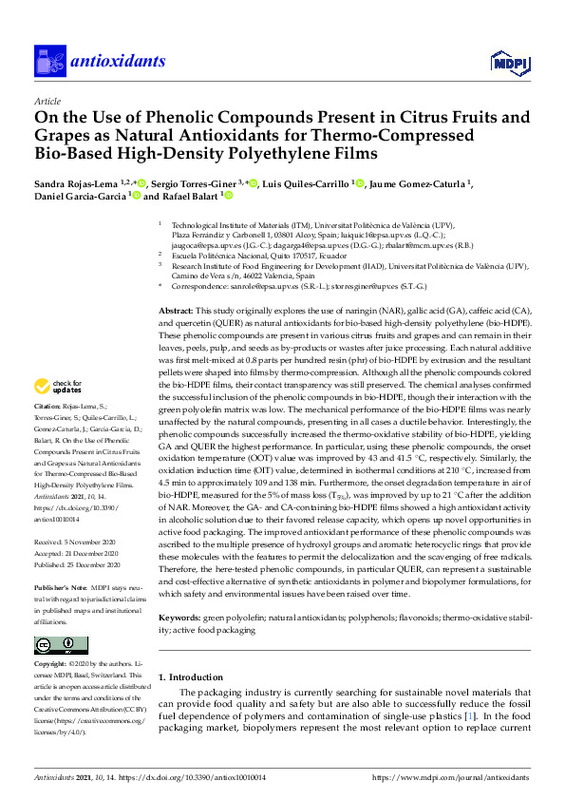JavaScript is disabled for your browser. Some features of this site may not work without it.
Buscar en RiuNet
Listar
Mi cuenta
Estadísticas
Ayuda RiuNet
Admin. UPV
On the Use of Phenolic Compounds Present in Citrus Fruits and Grapes as Natural Antioxidants for Thermo-Compressed Bio-Based High-Density Polyethylene Films
Mostrar el registro sencillo del ítem
Ficheros en el ítem
| dc.contributor.author | Rojas-Lema, Sandra Paola
|
es_ES |
| dc.contributor.author | Torres-Giner, Sergio
|
es_ES |
| dc.contributor.author | Quiles-Carrillo, Luis
|
es_ES |
| dc.contributor.author | Gómez-Caturla, Jaume
|
es_ES |
| dc.contributor.author | Garcia-Garcia, Daniel
|
es_ES |
| dc.contributor.author | Balart, Rafael
|
es_ES |
| dc.date.accessioned | 2022-04-27T06:28:20Z | |
| dc.date.available | 2022-04-27T06:28:20Z | |
| dc.date.issued | 2021-01 | es_ES |
| dc.identifier.uri | http://hdl.handle.net/10251/182150 | |
| dc.description.abstract | [EN] This study originally explores the use of naringin (NAR), gallic acid (GA), caffeic acid (CA), and quercetin (QUER) as natural antioxidants for bio-based high-density polyethylene (bio-HDPE). These phenolic compounds are present in various citrus fruits and grapes and can remain in their leaves, peels, pulp, and seeds as by-products or wastes after juice processing. Each natural additive was first melt-mixed at 0.8 parts per hundred resin (phr) of bio-HDPE by extrusion and the resultant pellets were shaped into films by thermo-compression. Although all the phenolic compounds colored the bio-HDPE films, their contact transparency was still preserved. The chemical analyses confirmed the successful inclusion of the phenolic compounds in bio-HDPE, though their interaction with the green polyolefin matrix was low. The mechanical performance of the bio-HDPE films was nearly unaffected by the natural compounds, presenting in all cases a ductile behavior. Interestingly, the phenolic compounds successfully increased the thermo-oxidative stability of bio-HDPE, yielding GA and QUER the highest performance. In particular, using these phenolic compounds, the onset oxidation temperature (OOT) value was improved by 43 and 41.5 ºC, respectively. Similarly, the oxidation induction time (OIT) value, determined in isothermal conditions at 210 ºC, increased from 4.5 min to approximately 109 and 138 min. Furthermore, the onset degradation temperature in air of bio-HDPE, measured for the 5% of mass loss (T5%), was improved by up to 21 ºC after the addition of NAR. Moreover, the GA- and CA-containing bio-HDPE films showed a high antioxidant activity in alcoholic solution due to their favored release capacity, which opens up novel opportunities in active food packaging. The improved antioxidant performance of these phenolic compounds was ascribed to the multiple presence of hydroxyl groups and aromatic heterocyclic rings that provide these molecules with the features to permit the delocalization and the scavenging of free radicals. Therefore, the here-tested phenolic compounds, in particular QUER, can represent a sustainable and cost-effective alternative of synthetic antioxidants in polymer and biopolymer formulations, for which safety and environmental issues have been raised over time | es_ES |
| dc.description.sponsorship | This research work was funded by the Spanish Ministry of Science and Innovation (MICI) project number MAT2017-84909-C2-2-R. | es_ES |
| dc.language | Inglés | es_ES |
| dc.publisher | MDPI | es_ES |
| dc.relation.ispartof | Antioxidants | es_ES |
| dc.rights | Reconocimiento (by) | es_ES |
| dc.subject | Green polyolefin | es_ES |
| dc.subject | Natural antioxidants | es_ES |
| dc.subject | Polyphenols | es_ES |
| dc.subject | Flavonoids | es_ES |
| dc.subject | Thermo-oxidative stability | es_ES |
| dc.subject | Active food packaging | es_ES |
| dc.subject.classification | CIENCIA DE LOS MATERIALES E INGENIERIA METALURGICA | es_ES |
| dc.title | On the Use of Phenolic Compounds Present in Citrus Fruits and Grapes as Natural Antioxidants for Thermo-Compressed Bio-Based High-Density Polyethylene Films | es_ES |
| dc.type | Artículo | es_ES |
| dc.identifier.doi | 10.3390/antiox10010014 | es_ES |
| dc.relation.projectID | info:eu-repo/grantAgreement/AEI/Plan Estatal de Investigación Científica y Técnica y de Innovación 2013-2016/MAT2017-84909-C2-2-R/ES/PROCESADO Y OPTIMIZACION DE MATERIALES AVANZADOS DERIVADOS DE ESTRUCTURAS PROTEICAS Y COMPONENTES LIGNOCELULOSICOS/ | es_ES |
| dc.relation.projectID | info:eu-repo/grantAgreement/AGENCIA ESTATAL DE INVESTIGACION//RYC2019-027784-I//AYUDA CONTRATO RAMON Y CAJAL-TORRES GINER/ | es_ES |
| dc.rights.accessRights | Abierto | es_ES |
| dc.contributor.affiliation | Universitat Politècnica de València. Instituto de Tecnología de Materiales - Institut de Tecnologia de Materials | es_ES |
| dc.contributor.affiliation | Universitat Politècnica de València. Departamento de Ingeniería Mecánica y de Materiales - Departament d'Enginyeria Mecànica i de Materials | es_ES |
| dc.contributor.affiliation | Universitat Politècnica de València. Instituto Universitario de Ingeniería de Alimentos para el Desarrollo - Institut Universitari d'Enginyeria d'Aliments per al Desenvolupament | es_ES |
| dc.description.bibliographicCitation | Rojas-Lema, SP.; Torres-Giner, S.; Quiles-Carrillo, L.; Gómez-Caturla, J.; Garcia-Garcia, D.; Balart, R. (2021). On the Use of Phenolic Compounds Present in Citrus Fruits and Grapes as Natural Antioxidants for Thermo-Compressed Bio-Based High-Density Polyethylene Films. Antioxidants. 10(1):1-23. https://doi.org/10.3390/antiox10010014 | es_ES |
| dc.description.accrualMethod | S | es_ES |
| dc.relation.publisherversion | https://doi.org/10.3390/antiox10010014 | es_ES |
| dc.description.upvformatpinicio | 1 | es_ES |
| dc.description.upvformatpfin | 23 | es_ES |
| dc.type.version | info:eu-repo/semantics/publishedVersion | es_ES |
| dc.description.volume | 10 | es_ES |
| dc.description.issue | 1 | es_ES |
| dc.identifier.eissn | 2076-3921 | es_ES |
| dc.identifier.pmid | 33375591 | es_ES |
| dc.identifier.pmcid | PMC7823819 | es_ES |
| dc.relation.pasarela | S\424758 | es_ES |
| dc.contributor.funder | AGENCIA ESTATAL DE INVESTIGACION | es_ES |
| dc.contributor.funder | Agencia Estatal de Investigación | es_ES |
| dc.subject.ods | 08.- Fomentar el crecimiento económico sostenido, inclusivo y sostenible, el empleo pleno y productivo, y el trabajo decente para todos | es_ES |
| dc.subject.ods | 09.- Desarrollar infraestructuras resilientes, promover la industrialización inclusiva y sostenible, y fomentar la innovación | es_ES |
| dc.subject.ods | 12.- Garantizar las pautas de consumo y de producción sostenibles | es_ES |








